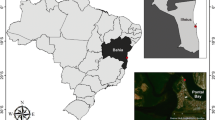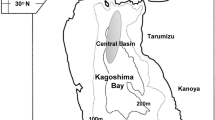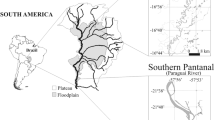Abstract
PostlarvalPenaeus orientalis kishinouye were simultaneously sampled at three fixed stations near the mouth of the Dagu River estuary in northwestern Jiaozhou Bay, China, at hourly intervals over a 49-h period in mid-June, 1984. The purpose of this sampling was to investigate the prawn’s recruitment into estuaries from coastal areas.
The abundance of the postlarvae varied considerably between stations and time, but they tended to concentrate at the surface. Maximum entropy spectral analysis was first applied in the study of prawn recruitment and it revealed that variations in abundance involved a pronounced 12.4 hr cycle. It was concluded that natural tidal cycles had a strong influence on the changes of postlarval abundance, in contrast with the minor effects of diet and other environmental cycles. A tidally varying cross-river gradient of postlarval density was found. During flood tides the postlarvae were more abundant in the axis of the channel than over the banks. The opposite held true during ebb tides. Mechanisms of the postlarval recruitment are discussed in terms of alternating movements of the postlarvae between the banks and the channels in response to tidal cycles.
Similar content being viewed by others
References
Andersen, N., 1974. On the calculation of filter coefficients for maximum entropy spectral analysis.Geophysics 39: 69–72.
Calmet, D., S. Charmasson, and F. Blanc, 1984. Maximum entropy spectral analysis applied to short series description in marine ecology.Oceanol. Acta 1: 77–86.
Childers, D. G., 1978. Modern Spectral Analysis. Ed. by D. G. Childers. IEEE Press, New York, 334 pp.
de Freitas, A. J., 1986. Selection of nursery areas by six southeast African Penaeidae.Estuarine, Coastal and Shelf Science 23: 901–908.
Edwards, R. R. C., 1978. The fishery and fisheries biology of penaeid shrimp on the Pacific coast of Mexico.Oceanogr. Mar. Biol. Ann. Rev. 16: 145–180.
Garcia, S., and L. Le Reste, 1981. Life cycles, dynamics, exploitation and mangement of coastal penaeid shrimp stocks. FAO Fish. Tech. Pap.203: 215.
Gibbs, P.E., C. Heip, and P.M.J. Herman, 1985. The Stability of a Benthic Copepod Community.In: Proceedings of the 19th European Marine Biology Symposium. Ed. by Gibbs, P. E. Cambridge University Press, New York, pp. 255–264.
Haury, L. R., J. A. McGowan, and P. H. Wiebe, 1978. Patterns and Processes in the Time—space Scales of Plankton Distributions.In: J. H. Steele (ed.) Spatial Pattern in Plankton Communities, Plenum Press, New York, pp. 277–327.
Hughes, D. A., 1969a. On the mechanisms underlying tide-assocated movements ofPenaeus duorarum.FAO Fisheries Report 3(57): 867–874.
Hughes, D. A., 1969b. Responses to salinity change as a tidal transport mechanism of pink shrimp,Penaeus duorarum.Biological Bulletin 136: 43–53.
Kang Yuande, 1983. Effects of inundation of salterns on the populations of postlarvalPenaeus orientatis. Yellow Sea Fisheries. (in Chinese)
Kirkegarrd, I., 1975. Observations of Penaeid Larvae around Australia.In: P. C. Yound (ed.), First Australian National Prawn Seminar. Aust. Gov. Publ. Serv., Canberra, pp. 54–59.
Kutkuhn, J. H., 1966. The role of estuaries in the development and perpetuation of commercial shrimp resources.Spec. Publ. Am. Fish. Soc. 3: 16–36.
Legendre L., and S. Demers, 1984. Towards dynamic biological oceanography and limnology.Can. J. Fish. Aquat. Sci. 41: 2–19.
Leonard, J. L., 1982. Transient rhythms in the swimming activity of Sarsia tubulosa (Hydrozoa).J. Exp. Biol. 96: 181–193.
Liu Ruiyu, 1955. On the shrimpPenaeus orientalis Kishinouye.Bull. Biol. 5: 17–20. (in Chinese)
Liu Ruiyu, 1983. Shrimp Mariculture Studies in China. Proceedings of the First International Conference on Warm Water Aquaculture-Crustacea (G. L. Rogers, R. Day and A. Lim, eds.). Brigham Young University Hawaii Campus, Office of Continuing Education, pp. 82–90.
Liu Ruiyu, 1984. Advances in shrimp culture in China. A Report at the First International Conference on the Culture of Penaeid Prawns/Shrimps. SEAFDEC Aquaculture Department, Iloilo, Philippines. Dec. 4–8, 1984.
Liu Ruiyu, Wu Shangqin, and Cai Naner, 1959. Preliminary Report on the Life History ofP. orientalis. Abstracts of papers presented at the First Nat. Symp. Embryol. 15–17. (in Chinese)
McCleave, J. D., and R. C. Kleckner, 1982. Selective tidal stream transport in the estuarine migration of glass cels of the American eel (Anguilla rostrata).J. Cons. Perm. Int. Explor. Mer. 40: 262–271.
Rijnsdrop, A. D., M. Van Stralen, and H. W. Van Der Veer, 1985. Selective tidal transport of North Sea plaice larvaePleuronectes platessa in coastal nursery areas.Trans. Am. Fish. Soc. 114: 461–470.
Rothlisberg, P. C., 1982. Vertical migration and its effect on dispersal of penaeid shrimp larvae in the Gulf of Carpentria, Australia.Fishery Bulletion 80(3): 541–554.
Rothlisberg P. C., J. A. Church, and A. M. G. Forbes, 1983. Modelling the advection of vertically migrating shrimp larvae.J. Mar. Res.,41: 511–538.
Staples, J. D., 1979. Seasonal migration patterns of postlarval and juvenile banana prawns,Penaeus merguiensis de Man, in the major rivers of the Gulf of Carpentaria, Australia.Aust. J. Mar. Freshwat. Res. 30: 143–157.
Staples J. D., 1980. Ecology of juvenile and adolescent banana prawns,Penaeus merguiensis, in a mangrove estuary and adjacent off-shore waters of the Gulf of Carpentaria. I. Immigration and settlement of postlarvae.Aust. J. Mar. Freshwat. Res. 31: 635–652.
Staples, J. D., and D. J. Vance, 1985. Short-term and long-term influences on the immigration of postlarval banana prawns,Penaeus merguiensis, into a mangrove estuary of the Gulf of Carpentaria, Australia.Mar. Ecol. Prog. Ser. 23: 15–29.
Ulrych, T. J., and T. N. Bishop, 1975. Maximum entropy spectral analysis and autoregressive decomposition.Rev. Geophysics and Space Phys. 13(1): 183–200.
Woodmansee, R. A., 1966. Daily vertical migration ofLucifer. Planktonic numbers in relation to solar and tidal cycles.Ecology 47(5): 847–850.
Wooldridge, T., and T. Erasmus, 1980. Utilization of tidal currents by estuarine zooplankton. Estuarine and CoastalMarine Science 11: 107–114.
Author information
Authors and Affiliations
Additional information
Contribution No. 1485 from the Institute of Oceanology, Academia Sinica
Rights and permissions
About this article
Cite this article
Yongshun, X., Ruiyu, L. & Yuheng, C. Recruitment of postlarval prawns,Penaeus Orientalis, to a tidal estuary of Jiaozhou Bay, China. Chin. J. Ocean. Limnol. 6, 290–299 (1988). https://doi.org/10.1007/BF02850453
Received:
Issue Date:
DOI: https://doi.org/10.1007/BF02850453




